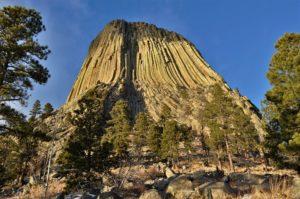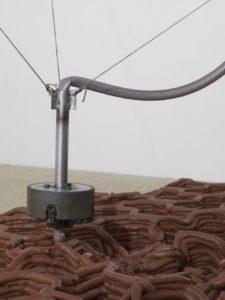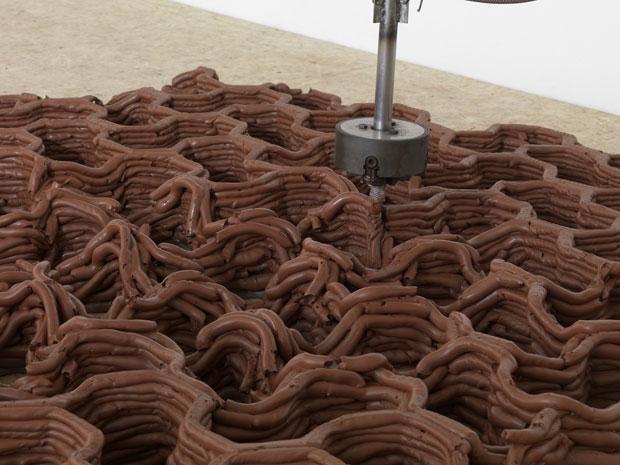Now, Anya Gallaccio, an artist well known for her work with organic matter and natural forms, is using a ceramic 3D printer to build a scaled model of the mountain out of clay for her newest installation. The installation, titled Beautiful Minds and showing at the Thomas Dane Gallery in London, is a collaboration with her students at the University of California San Diego and a product of her time in California; the artist lives and works in both San Diego and London. Gallaccio is not only “obsessed with the desert, the sand, the landscape” of San Diego, but also invoked the “technical inventiveness” that California is so well known for to build her 3D printer. 3D printing has been a big influence on the ceramic art world, and Gallaccio’s latest is no exception.
A single gantry spans the ceiling of her installation space at the gallery and suspends a computer-controlled hose in the air, which, for about two hours a day five days a week until the exhibit closes, will continually pump out wet clay hexagons as gallery assistants feed the clay into the vat. Over the next month and a half, the huge 3D printer will keep building clay layers, essentially building itself, until the scaled model of the mountain appears. The end result will look something like a “giant extruded coil pot.”Most of Gallaccio’s work is rife with contradictions: her 2008 work Under Starry Skies depicts a tree growing up out of a rock, and preserve ‘beauty’ features a slowly dying wall of 1,800 intertwined red gerberas. Beautiful Minds comes alive with a new contradiction: an ancient landscape, which forms the “backdrop to futuristic technological interventions.” What’s even more interesting is the installation’s name: whose mind does it reference, the artist’s, or the machine’s? Gallaccio personally sees the custom 3D printer she and her students built as a tool. The machine enables creation, and actually becomes part of the piece itself as it’s creating.
![‘Anya Gallaccio: Beautiful Minds’ at Thomas Dane Gallery, London, 2017. Courtesy the artist and Thomas Dane Gallery, London. [Image: Todd-White Art Photography]](https://3dprint.com/wp-content/uploads/2017/02/Beautiful-Minds-installation.jpg)
‘Anya Gallaccio: Beautiful Minds’ at Thomas Dane Gallery, London, 2017. [Image courtesy the artist and Thomas Dane Gallery / Todd-White Art Photography]
Gallaccio basically began the scenario, building Devil’s Tower out of clay into thin air, and then walks away from it, leaving it alone to do its work.“When the apparatus rumbles into life, a symphony of sepulchral wails and moans fill the space, giving the printing process a kind of melancholy grandeur, as if the span of geological time had been sped up to produce the mountain that emerges, slips and cracks before our eyes.”
“You set these things into place and then see what happens – I don’t interfere if it goes wrong. If the clay starts pouring on the floor, then that’s what is happening,” said Gallaccio.
In an interview with Elephant: The Art Culture Magazine, Gallaccio explained the idea of a certain lack of control in her piece, both in the artist herself with the final product, and between the machine and its wet clay material. She notes that some of the inspiration, and explanation of control issues, for this installation does in fact stem from Close Encounters of the Third Kind, mentioning that Dreyfuss’ character is obsessed with the mountain, which ends up leading him on a journey.
“There seemed a lot of parallels between his character and the risk and uncertainty of being an artist,” Gallaccio said. “Maybe this is an affirmation of not knowing? Working without an expected outcome. Whilst it is not as apparent in some examples, those ideas of control are pretty much always in play. Control becomes even more convoluted in this project. We can capture a crazy amount of information with digital tools, but this still needs to be translated, interpreted-so as with everything something is lost, it’s a subjective process. The system and logic of the programme and code are at odds with the physical properties of the clay. The slippage between the logic of the computer and the limits of the material, this makes the work. I am anticipating the outcome being gestural and expressive, despite the systematic path of the code.”
Once the print job is finished, the sculptural mountain will then be broken up into pieces and recycled, because it’s too full of air bubbles to stand up well under firing, and is much too big to be taken out of the gallery all in one piece. But Gallaccio actually doesn’t mind that the piece will ultimately meet its end in the gallery.
“I like the absurdity, that we build this mountain and then it has to be destroyed,” she noted.
Gallaccio’s Beautiful Minds will be at the Thomas Dane Gallery in London until March 25th. Admission to the gallery is free. Discuss in the Ceramic 3D Printer forum at 3DPB.com.
[Sources: Apollo Magazine, New York Times, Elephant: The Art Culture Magazine, Thomas Dane Gallery]
Subscribe to Our Email Newsletter
Stay up-to-date on all the latest news from the 3D printing industry and receive information and offers from third party vendors.
You May Also Like
3D Printing Unpeeled: New Arkema Material for HP, Saddle and Macro MEMS
A new Arkema material for MJF is said to reduce costs per part by up to 25% and have an 85% reusability ratio. HP 3D HR PA 12 S has been...
3D Printing News Briefs, January 20, 2024: FDM, LPBF, Underwater 3D Printer, Racing, & More
We’re starting off with a process certification in today’s 3D Printing News Briefs, and then moving on to research about solute trapping, laser powder bed fusion, and then moving on...
3D Printing Webinar and Event Roundup: December 3, 2023
We’ve got plenty of events and webinars coming up for you this week! Quickparts is having a Manufacturing Roadshow, America Makes is holding a Member Town Hall, Stratafest makes two...
Formnext 2023 Day Three: Slam Dunk
I’m high—high on trade show. I’ve met numerous new faces and reconnected with old friends, creating an absolutely wonderful atmosphere. The excitement is palpable over several emerging developments. The high...



![Anya Gallaccio [Image: Artpace]](https://3dprint.com/wp-content/uploads/2017/02/Anya-Gallaccio-300x300.jpg)































